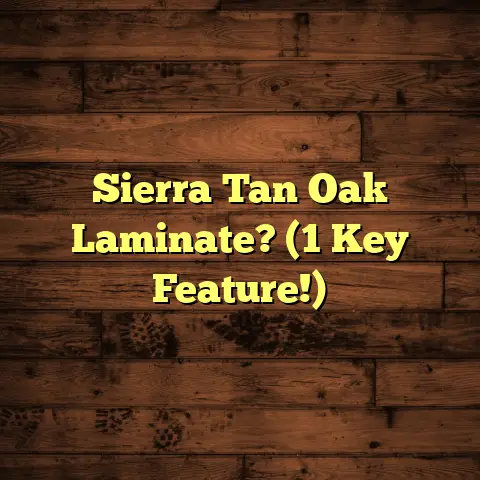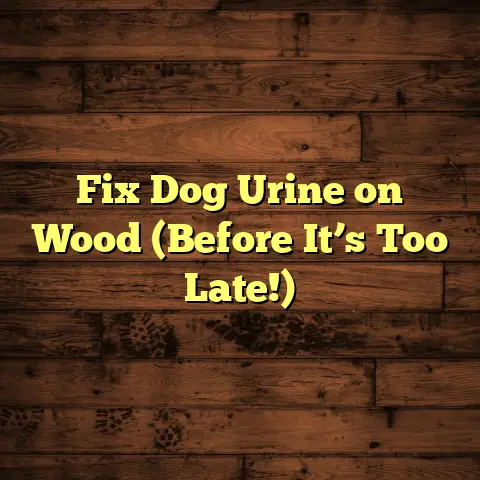Polyurethane on Hardwood Floors: How To? (3 Tips)
Ever walked into a room and been stopped
dead in your tracks by the sheer beauty of
a hardwood floor?
I have.
Countless times.
And let me tell you, more often than not, that “wow” factor comes down to one thing: a flawless polyurethane finish.
I’ve seen floors that were dull, scratched, and frankly, looked like they’d given up on life, completely reborn with polyurethane.
Imagine this: Sunlight streaming through your windows, bouncing off a glossy, smooth surface.
The rich grain of the wood is popping, and every step you take feels like a celebration of craftsmanship.
That’s the power of polyurethane.
I’ve witnessed
homeowners’ faces light up as they see their
old floors transform into something spectacular.
The satisfying whirr of the sander, the gentle swish of the brush, the subtle aroma of the finish drying…
It’s a symphony of transformation.
And trust me, achieving that professional
look isn’t as daunting as you might think.
I’m here to guide you through the process, step by step, so you can experience the joy of revitalizing your own hardwood floors.
Section 1: Understanding Polyurethane and Its Benefits
So, what is this magical elixir that can breathe new life into tired hardwood?
Polyurethane is a synthetic resin that forms a tough, protective coating when applied to wood.
Think of it as a shield against the wear and tear of daily life – kids, pets, furniture, you name it.
Chemically speaking, it’s a polymer made up of urethane links, which gives it that incredible durability and flexibility.
Now, you’ve got two main players in the polyurethane game: water-based and oil-based.
Let’s break down the pros and cons of each:
Water-Based Polyurethane:
- Pros: Low odor (a huge plus if you’re sensitive to smells), fast drying time (meaning you can get back on your floors sooner), and it doesn’t yellow over time (keeping your light-colored woods looking fresh).
- Cons: Can be a bit pricier than oil-based, and some say it’s not quite as durable (though modern formulations are closing the gap).
Oil-Based Polyurethane:
- Pros: Generally more affordable, offers a rich, amber hue that can enhance the warmth of your wood, and it’s known for its excellent durability.
- Cons: Strong odor (you’ll definitely want good ventilation), longer drying time, and it tends to yellow over time (which can be a plus for some, adding a vintage feel).
Personally, I often lean towards water-based polyurethane for its ease of use and low odor, especially in homes with kids or pets.
But oil-based definitely has its place, particularly if you’re after that classic, warm look and don’t mind the extra drying time.
Why choose polyurethane over other finishes like
varnish or shellac?
Simple: durability and
moisture resistance.
Polyurethane forms a much tougher, more flexible film that can withstand scratches, scuffs, and spills far better than other options.
It’s also much easier to maintain.
A quick
sweep and mop, and you’re good to go.
Take a look at this comparison table I’ve put together, based on my years of experience:
According to the National Wood Flooring
Association (NWFA), polyurethane is the most
widely used finish for hardwood floors in the
United States, accounting for over 70% of the
market.
That says something, right?
Section 2: Preparation – The Key to a Successful Application
Okay, let’s get down to brass tacks.
The
secret to a truly stunning polyurethane finish
isn’t just about the product itself.
It’s about the prep work.
Trust me, I’ve seen
countless DIY projects go south because
people skipped this crucial step.
Think of it like painting a car.
You wouldn’t
just slap on the new coat of paint without
sanding and priming, would you?
Same principle applies here.
Here’s a breakdown of the steps you need to take to ensure a smooth application process:
1. Thorough Cleaning:
This is non-negotiable.
You need to remove
every speck of dirt, dust, grease, and old
finish from your floors.
I recommend starting with a good sweep or vacuum to get rid of loose debris.
Then, follow up with a thorough cleaning using a wood floor cleaner specifically designed for your type of finish.
Avoid using harsh chemicals or abrasive cleaners, as these can damage the wood.
I personally love using Bona Hardwood Floor
Cleaner.
It’s pH-neutral, safe for all
uncoated hardwood floors, and it leaves a
streak-free shine.
2. Sanding the Surface:
Now, this is where things get a little more
involved.
Sanding is essential for creating a
good bond for the polyurethane and ensuring an
even texture.
The grit of sandpaper you’ll need depends on the condition of your floors:
- For floors with a previous finish: Start
with a coarse grit (like 60-80) to remove
the old finish, then move to a medium grit
(like 100-120) to smooth out the surface.
Finish with a fine grit (like 150-180) for a perfectly smooth finish. - For bare wood floors: Start with a medium grit (like 100-120) and finish with a fine grit (like 150-180).
You can use a drum sander for large areas, but
be careful!
These machines are powerful and can
easily damage your floors if you’re not experienced.
For edges and corners, an orbital sander or even hand sanding is best.
Remember to always sand in the direction of the wood grain to avoid creating unsightly scratches.
And for goodness sake, wear a dust mask! Sanding creates a lot of dust.
3. Filling Gaps and Cracks:
Once you’ve sanded, you’ll likely notice some gaps or cracks in your floors.
These need to be filled in with wood filler for a seamless finish.
Choose a wood filler that matches the color of your wood as closely as possible.
Apply the filler with a putty knife, making sure to overfill the gaps slightly.
Once the filler is dry, sand it down flush with the surrounding wood.
I’ve found that using a flexible putty knife helps to avoid gouging the surrounding wood.
Recommended Tools and Products:
- Vacuum cleaner with a HEPA filter
- Wood floor cleaner (e.g., Bona Hardwood Floor Cleaner)
- Drum sander (for large areas)
- Orbital sander (for edges and corners)
- Sandpaper (various grits)
- Dust mask
- Wood filler
- Putty knife
- Tack cloth
After sanding and filling, use a tack cloth to remove any remaining dust from the floor.
This is a crucial step!
Even the smallest
particle of dust can ruin your finish.
Section 3: Application Techniques – Achieving a Flawless Finish
Alright, now for the fun part: actually applying the polyurethane!
Think of this as an art form.
It takes
practice, patience, and a little bit of finesse.
But trust me, with the right techniques, you can achieve a professional-looking finish that will make your floors the envy of the neighborhood.
Here are my top three tips for a flawless application:
Tip 1: Choosing the Right Tools
The tool you use to apply the polyurethane can have a huge impact on the final result.
You’ve got three main options: brushes, rollers, and sprayers.
- Brushes: Best for small areas, edges,
and corners.
Choose a high-quality brush with natural bristles for a smooth, even application. - Rollers: Great for large areas.
Use a short-nap roller (about 1/4 inch) to avoid creating bubbles in the finish. - Sprayers: Ideal for achieving a perfectly
smooth, even finish on large areas.
However, sprayers require more skill and experience to use properly.
I personally prefer using a combination of a
brush and a roller.
I use the brush for the
edges and corners, and the roller for the main
floor area.
Tip 2: Mastering the Technique
The key to applying polyurethane evenly is to work in small sections and maintain a wet edge.
Start by pouring a small amount of polyurethane onto the floor.
Using your brush or roller, spread the polyurethane evenly over the section, working in the direction of the wood grain.
Make sure to overlap each stroke slightly to avoid creating lap marks.
As you move to the next section, blend the wet edge of the new section with the wet edge of the previous section.
This will help to create a seamless finish.
Avoid applying too much polyurethane at once, as this can lead to drips and runs.
If you do notice any drips or runs, smooth them out immediately with your brush or roller.
Tip 3: Timing and Coats
Patience is key when it comes to applying
polyurethane.
You need to allow each coat to
dry completely before applying the next one.
The drying time will vary depending on the type of polyurethane you’re using and the humidity in your home.
Generally, water-based polyurethane dries faster than oil-based polyurethane.
Check the manufacturer’s instructions for specific drying times.
I usually recommend waiting at least 4-6 hours between coats for water-based polyurethane, and 24 hours between coats for oil-based polyurethane.
Before applying the next coat, lightly sand the floor with a fine-grit sandpaper (like 220 grit) to create a smooth surface.
This will also help the new coat of polyurethane to adhere properly.
How many coats should you apply?
That depends
on the level of durability you’re looking for.
I typically recommend applying at least three coats of polyurethane for hardwood floors that see a lot of traffic.
For floors in low-traffic areas, two coats may be sufficient.
A Personal Anecdote:
I once worked on a project where the homeowner insisted on only applying one coat of polyurethane to save time.
Big mistake!
The floor looked great at first,
but within a few months, it started to show
signs of wear and tear.
The homeowner eventually had to sand the floor down and apply additional coats of polyurethane.
So, trust me, don’t skimp on the coats!
It’s
worth the extra time and effort in the long run.
Section 4: Maintenance and Longevity of Polyurethane-Finished Floors
Congratulations! You’ve successfully applied polyurethane to your hardwood floors.
Now, the key is to keep them looking beautiful for years to come.
Here are some tips on how to care for and maintain polyurethane-finished hardwood floors:
Cleaning Methods:
- Sweep or vacuum regularly: This will remove dirt, dust, and debris that can scratch the finish.
- Mop with a damp cloth: Use a wood floor
cleaner specifically designed for
polyurethane finishes.
Avoid using excessive water, as this can damage the wood. - Clean up spills immediately: Wipe up spills with a clean, dry cloth to prevent staining.
Recommended Products:
- Bona Hardwood Floor Cleaner
- Armstrong Hardwood & Laminate Floor Cleaner
- Weiman Hardwood Floor Cleaner
Preventive Measures:
- Use rugs and mats: Place rugs and mats in high-traffic areas to protect the finish from wear and tear.
- Use furniture pads: Attach felt pads to the legs of furniture to prevent scratches.
- Avoid wearing shoes with cleats or high heels: These can damage the finish.
- Control humidity levels: Excessive humidity can cause the wood to swell and warp.
Minor Repairs and Touch-Ups:
- Scratches: Minor scratches can often be buffed out with a fine-grit sandpaper and a fresh coat of polyurethane.
- Dents: Dents can be repaired by steaming the wood to raise the grain.
- Water spots: Water spots can often be removed with a damp cloth and a mild abrasive cleaner.
Signs It’s Time for Reapplication:
- The finish is dull and worn: If your floors no longer have a shine, it’s likely time for a reapplication of polyurethane.
- The finish is scratched or damaged: If your floors have numerous scratches or damaged areas, it’s time to consider reapplying the finish.
- The wood is exposed: If the wood is exposed in any areas, it’s essential to reapply the finish to protect the wood from moisture and damage.
According to a study by the National Wood Flooring Association, polyurethane-finished hardwood floors can last for 10-20 years with proper maintenance.
Conclusion
Applying polyurethane to your hardwood floors is a transformative experience.
It’s a chance to breathe new life into your home, to create a space that is both beautiful and durable.
I know it can seem daunting at first, but with the right knowledge and techniques, you can achieve stunning results.
Don’t be afraid to take the plunge and tackle your flooring project with confidence.
Imagine walking into your home and being greeted by the warm glow of perfectly finished hardwood floors.
Imagine the compliments you’ll receive from friends and family.
Imagine the pride you’ll feel knowing that you transformed your floors with your own two hands.
The possibilities are endless.
So, what are you waiting for?
Call to Action
Now I’d love to hear from you!
Have you ever applied polyurethane to your hardwood floors?
What tips or tricks did you learn along the way?
Share your experiences in the comments below!
Let’s create a community of DIY enthusiasts eager to learn and share tips.





